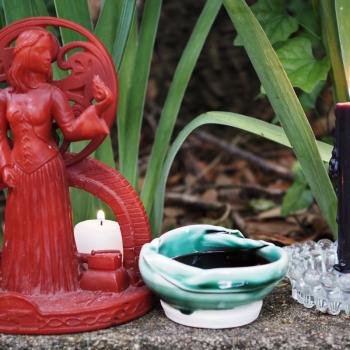How the Ouija board, rooted in philosophies with no room for a Devil and once regarded as something safe enough for Normal Rockwell paintings and the comedy of I Love Lucy, became a prime target of America’s Satanic Panic
In my social media wanderings, I recently came across a photo of a note purportedly put up at a Subway restaurant: “OUIJA BOARDS AND SEANCES ARE NOT ALLOWED TO BE PERFORMED IN THIS SHOP! Haunt your own house.”
Well, I found that amusing and shared it, noting that if I saw something like that I’d be tempted to show up with a group of friends clad in black and chanting something mysterious.
To my surprise, though, some people replied with comments showing a fear of the Ouija board that could have been right out of the occult scare of the 1980s.
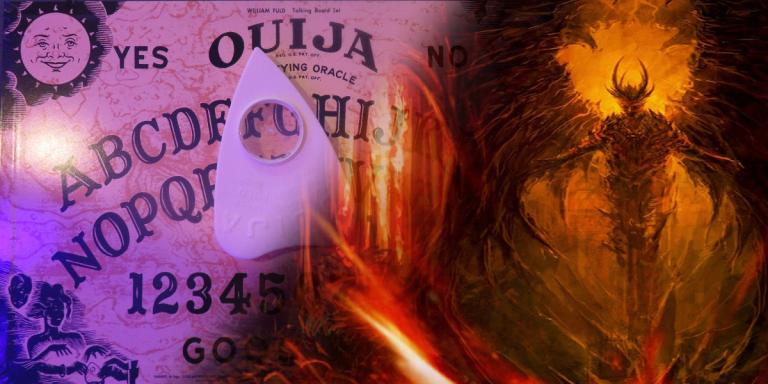
Friends, it seems we need to have a talk about one of Baltimore’s magickal gifts to the world.
To do that, we need to start with the history of spiritualism.
The 1830s and 1840s saw the United States come into its own. Emerson’s 1837 speech “The American Scholar”, sometimes called the US’s declaration of intellectual independence from Europe, laid out a vision for a distinctly American cultural identity. The country was expanding its territory rapidly (stealing it from Native peoples and from Mexico). In 1840 an American charted Antarctica, establishing that there was a whole unknown continent there and not merely islands.[Wood] In 1844, American Samuel Morse sent the first telegraph message, demonstrating whole new possibilities in communication.
These decades also saw the establishment of dozens of utopian communities in the US, as well as the rise of causes such as abolition, coeducation, temperance, and prison reform.[Stuart]
There was a great feeling of possibility in the air. Who knew what discovery or invention lie right around the corner? And this extended to an interest in the spiritual and paranormal.
At this time, the ideas of two paranormalists from the previous century were in vogue: the mystic Emanuel Swedenborg, who claimed that God had appointed him to reveal the true meaning of the Bible, that such revelation was the Second Coming, and that God had allowed him to speak with both angels and with the spirits of the dead; and Anton Mesmer, who claimed to be able to heal people via “animal magnetism”, what we now call hypnotic suggestion.
Emanuel Swedenborg
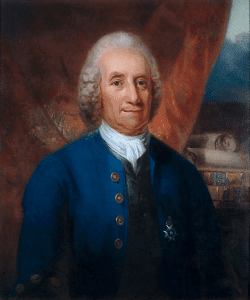
Eighteenth century mystic Emanuel Swedenborg had a great and under-appreciated impact on subsequent Western European and American beliefs about heaven, hell, and the afterlife. What’s important about him for our purposes is that he seems to be the first in modern Christianity to advance a claim to be able to speak to the spirits of the dead[Stefanidakis] and get away with it.
In cultures where ancestor veneration is practiced, some degree of communication with the spirits of the departed is part of the deal. And before Swedenborg, others operating in a Christian context had claimed to be in contact with angels — famously, John Dee and Edward Kelley. But the Old Testament’s prohibitions on necromancy (e.g., Deuteronomy 18:10-13 and Leviticus 20:27) kept the idea of communication with the dead limited to an occult underground in medieval Europe, until the Enlightenment allowed people to question Biblical literalism and still be regarded as decent Christians.
(By “necromancy” here we mean only communication with the dead; it has been conflated with black magic because of those Biblical prohibitions.)
Swedenborg didn’t claim that he had raised the spirits of the dead in this world, but rather that God was enabling him to enter the spirit world. All part of his position as a Chosen One — he claimed that, starting around 1744, God had allowed him “to be constantly and uninterruptedly in company with spirits and angels, hearing them converse with each other, and conversing with them…to hear and see stupendous things in the other life which has never before come to the knowledge of any man”.[Stefanidakis]
According to him, a person’s “inner nature” communicates constantly with spirits in a way that we cannot understand or perceive, and that while imperceptible it is this communication that enables thought. Without it, “man would no more think than a beast, nor any differently from a beast. Indeed, were all commerce with spirits cut off, a man would instantly die.”[Smyth]
In his metaphysics, contact with the spirit world is not only not evil, some degree of it is essential.
However, he also claimed that there was a danger to one “who speaks with spirits, or who manifestly perceives their operation”, because “the spirit speaking is in the same principles as the man, whether these be true or false.”[Smyth] He saw communication with spirits as not so much a source of truth as an intensification of one’s own exiting thoughts — thus while it was safe for him (as God’s chosen one) to speak with spirits, others who might claim to be in contact with spirits but told a different story were being misled.
In Swedenborg’s cosmology there are various levels of heaven and hell, but there is no devil, only the spirits of evil humans, who are drawn to hell by their own natures, not cast down by God. God, not a devil, rules the hell realms, and the punishments of the damned are not from an angry God but the only way to deter the spirits there from doing further evil.[Ager, 453-458].
Swedenborg’s ideas were not limited to his concept of the afterlife and communication with the dead. Emerson and Thoreau were influenced by his ideas about “correspondences” between the spiritual and material worlds.[Harding] But as usual, claims of about the afterlife captured the general imagination much more than any philosophical points.
Anton Mesmer
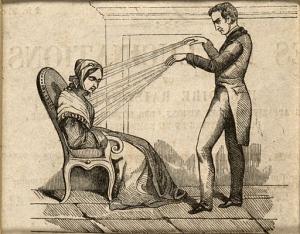
Anton Mesmer is the guy who gave us the verb “mesmerize”. After obtaining a medical degree in Vienna 1766, in the 1770s he began experimenting with using magnets to treat sick people. He soon discovered that will of the physician was more important than the magnets — i.e., what we would call today a “placebo effect”; by 1776 he had abjured the use of magnets or electricity.
Instead he proposed the existence of a “magnetic fluid” that permeated everything: “a mutual influence between the Heavenly Bodies, the Earth and Animate Bodies,” which could be consciously manipulated to perform healing.[“Franz…”]
Mesmer moved from Vienna to Paris in 1778, after a scandal when he failed to cure a young blind piano prodigy. In Paris he attracted many aristocrats as clients, prompting Louis XVI to appoint a commission — which included Benjamin Franklin — to investigate. The commission found no evidence to support the existence of animal magnetism, and also highlighted the scandal of male Mesmerists stroking the bodies female patients.[Franklin]
Mesmer’s ideas may not have been new — anyone who is familiar with Chinese Medicine will recognize the similarity to the idea of qi — but Mesmer managed to crank up the drama and emotionalism in ways that got attention. He evolved from making passes with his hands over the patient, to using an apparatus (the baquet) of a wooden tub filled with iron filings, iron rods, and water, set up in a dimly-lit room where he burned incense and played unearthly music on the glass armonica (somewhat like the sound of “singing bowls”[Zeitler, “Bowls”]), as he performed his magnetic magic in purple wizard’s robes.[Zeitler, “Mesmer”; Rose]
In the excitement that Mesmer and his followers created in their patients, sometimes these trace states would lead to “crises” of delirium or convulsions as the flow of animal magnetism was restored. People in such states sometimes claimed to have clairvoyant powers, which they would use to diagnose themselves or others and prescribe treatments.[Dupotet 72-77; Braid 36-39].
Some even claimed to be in contact with the spirit world, seeing much the same phenomena that Swedenborg claimed to have years before.[Podmore 198-201]
Modern Spiritualism: The Fox Sisters
In 1843, a young man named Andrew Jackson Davis in Poughkeepsie, New York, started experimenting with Mesmeric trances. In March of 1844, he fell into a spontaneous trance and had a mystical experience. In his autobiography he claimed that he found himself forty miles away in the Catskill Mountains; and in the presence of the spirits of Galen, the famed Roman physician, and of Emanuel Swedenborg. He claimed that these spirits taught him about healing and about the spiritual nature of the universe.[Davis, “Staff”, 231-248; Greer]
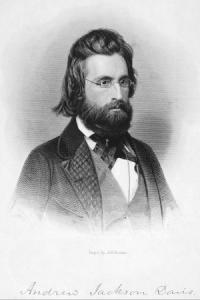
In 1847, Davis published a book titled The Principles of Nature, Her Divine Revelations, and a Voice to Mankind, in which he claimed that Mesmer’s magnetism gave him powers of clairvoyance, healing, and Swedenborgian spiritual communication,[Davis, “Principles”, vii, xi, 45] just as Mesmerists in Europe had claimed decades before.
According to Davis, “spirits commune with one another while one is in the body and the other in the higher Spheres.” And, perhaps influenced by the telegraphic times, he saw a coming age of closer communication with the spirit world: “[A]ll the world will hail with delight the ushering in of that era when the interiors of men will be opened, and the spiritual communication will be established….”[Davis, “Principles”, 675]
He seems to have created a self-fulfilling prophecy: in 1848, two young sisters in Hydesville, New York, played a prank on their mother and their neighbors, and the country went cuckoo for spirits.
During the winter of 1847-48, Maggie (then age 15) and Katy (11) Fox plotted to annoy their mother Margaret and scare their niece Elizabeth by making mysterious rapping sounds at night.[Davenport, 84]
Lying in bed, the sisters would drop apples tied on strings to the floor, and then pull them back up and hide them in the blankets. Later they progressed to making strange noises by cracking and popping their joints, using any available surface as a sounding board.[Stuart; Davenport, 84, 90] (It’s been suggested that the girls may have had unusual flexibility in their toes and been able to snap the first and second toes against each other as most of us can snap our fingers.[Drabelle])
The girls had no intent of assigning the rapping noises to spirits, but their mother suggested it and the girls ran with the idea. The facts that at the time the family was living in a cottage reputed to be haunted, and that Margaret was somewhat superstitious,[Weisberg] helped set the stage.
Soon they were talking with a “spirit” who would answer questions in coded rapping noises. Margaret Fox then called in neighbors to witness the “spirit rapping”.
As Maggie later explained,
“Well, we were led on unintentionally by my good mother in the perpetration of this great wrong. She used to say when we were sitting in a dark circle at home: ‘Is this a disembodied spirit that has taken possession of my dear children?’ And then we would ‘rap’ just for the fun of the thing, you know, and mother would declare that it was the spirits that were speaking.
“Soon it went so far, and so many persons had heard the ‘rappings’ that we could not confess the wrong without exciting very great anger on the part of those we had deceived. So we went right on.
“It is wonderful, indeed, how two little children could have made this discovery, and how, by simply obeying the natural thirst for the marvelous, in others, and their inherent superstition, they should have advanced step by step, in the fraud, deluding those who most ardently wished to be deluded.
“Until first suggested to us by our mother, who was perfectly innocent in her belief, the thought of ‘spirits’ had never entered our heads. We were too young and too simple to imagine such a thing.”[Davenport, 87-93]
(Of course, we may question how innocent the girls’ intentions actually were at the time versus how they recalled it as adults, decades later.)
Over the next few days and weeks the house was crowded with visitors come to witness the phenomenon. As neighbors asked more and more questions of the “spirit”, the girls had to up their game by creating a backstory. Taking advantage of a local rumor, they made it the ghost of a murdered man supposedly buried deep in the basement.[Conliffe]
A local man published an account of the rapping (with the inventive title A Report of the Mysterious Noises Heard in the House of John D. Fox, in Hydesville, Arcadia, Wayne County). A copy of the report happened to come to the attention of the girl’s elder half-sister, Leah Fox Fish, then a 33-year old divorced mother living in some distance away in Rochester.[Stuart]
Leah was apparently familiar with Andrew Jackson Davis’s ideas. She may have initially believed that her younger sibling’s conversation with ghosts was the “spiritual communication” Davis had foreseen. But she soon learned the truth from her sisters, and saw a potential for a more profitable way of making a living than by giving music lesson to the children of the wealthy.[Stuart]
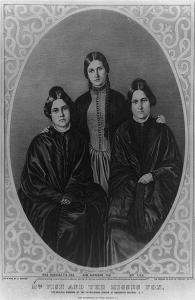
Rochester had been a boom town since the opening of the Erie Canal in 1825 — overcrowded, with poor sanitation, regular disease epidemics, and high mortality rates; death was not a stranger.[Occult Museum] People were anxious for word from the other side. Soon Maggie and Katy — as well as their mother — were living in Rochester with Leah, who had moved to a house next to a graveyard[Stuart] to provide the proper ambiance. For a dollar a head, visitors could attend a seance with the sisters.
With money to be made, the Fox sisters soon had plenty of competition. By 1850, forty families in upstate New York claimed to have the same line to the spirit world as the Foxes; an 1851 tally of spirit mediums in New York found over one hundred.[White]
Katy and Maggie took the show on the road to cities including Philadelphia, Washington, D.C., Cleveland, and St. Louis, and the “spirit communication” became more elaborate. For example, Katy would deliver messages directly by speaking or writing (sometimes writing one message while speaking another), or would have words spontaneously appear on blank cards.[Abbott]
Of course there were skeptics, and sometimes they were able to prove their point. At one seance in Buffalo, skeptics managed to get the sisters to agree to put pillows under their feet; deprived of their soundboard, the sisters were unable to produce the raps. Leah offered a lovely circular explanation: the bad vibes of skeptics cynics polluted communication with the spirit world, so the sisters could only contact the other side in the presence of true believers.[White]
Within a few years, Maggie — the star of the show — grew into a young woman, and met and fell in love with Elisha Kane, a famous Arctic explorer. Kane loved her but was embarrassed by the Spiritualist fakery;[White] he encouraged her to give up her “life of dreary sameness and suspected deceit.”[Abbott] They were engaged, and Maggie retired to attend school (at Kane’s expense). But he fell ill on an expedition and died, and his upper-class family cut her out. In her grief, and perhaps from the shame and self-loathing that Spiritualist fakery caused her, she began drinking heavily.
In 1888, four decades after their prank, Maggie publicly confessed to the trickery, with Kate’s support. But by then, “modern” Spiritualism has not just become thoroughly embedded in American culture — by that time an estimated eight million Americans were Spiritualists — but had crossed the Atlantic. It was the first American cultural export to make a splash in Great Britain.[Abbott; White]
(Modern Spiritualism helped birth Theosophy, which played a key role in both in popularizing Buddhism and Hinduism in the West — and even helped unite the divided schools of Buddhism into a single world faith. Theosophy was also important in the establishment of the Heremetic Society, precursor to the Heremetic Order of the Golden Dawn, an important group in the Western occult/magickal tradition. I wrote about this history in my book Why Buddha Touched the Earth.)
A Positive Vision of the Cosmos
The Fox sisters were frauds; Davis had something of the con man about him but it strikes me that he had had some genuine mystical experiences. He later distanced himself from Spiritualism and went to medical school, practiced for a while, and then opened a bookstore.
But what’s important for our purposes is that the vision of the spirit world they put forth — whether based on sincere belief or deliberate fraud — was essentially a positive one.
As Davis wrote,
The structure of the Universe…presents an indestructible basis of hope and faith, and a corresponding foundation of human action. It is as a mirror in which are reflected all corresponding beauties yet uncreated, but proved to be in embryo by the universal teachings of natural law. The whole is beautiful. The whole is as one Body, and God the Soul and Father of all living and unliving things. Everything is perfect in its way and state of being. Everything is necessary — even indispensable. Everything is pure, even divine and celestial. Everything teaches harmony, and universal reciprocation by an unfailing manifestation of the same. Everything is of, in, through, and to, the Divine Mind. All things are parts of Him; and these are as one Whole, even Nature, Man, and Heaven.[Davis, “Principles”, 676]
No demons possessed Spiritualist mediums; the gates of Hell did not open during any of these seances. Only the spirits of the departed spoke. These spirits might lie, mislead, or be ignorant, but the danger was limited to that. Spiritualism kept with its Swedenborgian roots in omitting superhuman devils and demons from its cosmology. And unlike the “predestination” of Calvinism, the faith tradition of many earlier Americans, Spiritualists believed they could act on their own to merit salvation.[Abbott]
And spiritualism’s claim to evidence of life after death offered solace in dark times. The White house played host to seances after the Lincolns lost their young son to illness 1862; the industrial-scale carnage of the Civil War brought in thousands who were looking for a way to connect with loved ones killed.[McRobbie]
Spiritualism was also connected to the general urge for social reform of the time. It put female mediums in the center, smashing Victorian propriety — even allowing some women to become financially independent. It spoke of a commonality of souls regardless of race, ethnicity, gender, and took a universalist attitude toward religious affiliations.[Stuart]
It was from this milieu — not one of black magic — that the Ouija board emerged.
The “Good Luck” Board
It took a long time to get a message out of the spirits via rapping. The Fox sisters originally used a “two knocks for yes, one knock for no” sort of code,[Conliffe] moving on assigning numbers to letters of the alphabet[Stuart]. So to transmit the word “the” might take 20 + 5 + 8 = 33 raps. Surely there must be a quicker way.
In 1854, a Prussian music professor of music filed a British patent on a “psychograph”, described as an “apparatus for indicating persons thoughts by the agent of nervous electricity”. The patent details the device as consisting of rods connecting a disc for the operator’s hand with a tracer which moves to point to letters or numbers.
It’s notable that the inventor of this proto-talking-board doesn’t mention the occult or spiritual at all. As Robert Murch, a leading historian of the boards, pointed out, “Though many spiritualists and practitioners of the occult claim to use talking boards to communicate with the other side, the inventors, or shall we say patentees, make no such claim. As you will see, almost from the beginning, talking boards began to take on lives of their own.”[Murch]
It’s also notable that this patent was filed two years after the “ideomotor” effect was first described by William B. Carpenter as being the driving force behind various hypnotic (or “electro-biological”) phenomena, as well as the operation of divining rods and prediction pendulums.[Carpenter]
By the 1860s, other devices for communication with the unseen were recorded in Europe: the “dial-plate”, with letters on a dial and a moving needle; and a turning table with letters around the edge, which would rotate when the medium placed their fingers on it.[Murch]
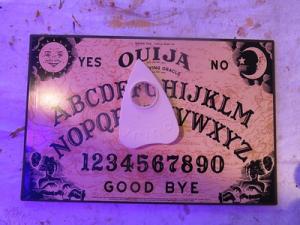
Fabrice Florin
In 1886, newspapers reported that a new phenomenon was sweeping spiritualist groups in Ohio: the “talking board”. This was recognizably the same as the Ouija board: letters, numbers, and a planchette to indicate the message.[McRobbie] Presumably these were homemade.
In 1890, Charles Kennard got a group of investors together in Baltimore, to form the Kennard Novelty Company to commercialize the talking boards that were becoming popular . None of them were spiritualists, but one, Elijah Bond, had a sister-in-law, Helen Peters, whom Bond claimed was “strong medium”.
So when they needed a name for their product, Peters asked the board itself what they should call it. “Ouija” was the reply. When they asked what that meant, the board replied, “Good luck.”
Later Peters acknowledged that she was at the time wearing a locket bearing the picture of a woman with a name like “Ouija” above her head. It may be that the woman in the picture was novelist and activist Ouida (Maria Louise Ramé), and that “Ouija” was simply a misreading of that.[McRobbie]
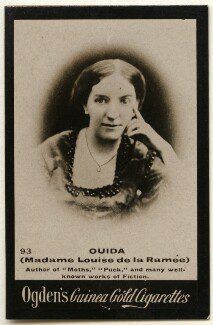
The Ouija board quickly achieved commercial success. By 1892, the Kennard Novelty Company had two factories in Baltimore, two in New York, two in Chicago, and one in London. By 1893, Kennard and Bond were out of the company, and William Fuld — the name most associated with the board, though he was not even one of the initial investors — was running things.[McRobbie]
When Fuld was asked if he believed the board had anything supernatural about it, he said “I should say not. I’m no Spiritualist. I’m a Presbyterian.”[Cassie] It was all business, the novelty business — about as sinister as the “love tester” machine at your local bar.
Just as people had turned to Spiritualism during the Civil War, so the Ouija board surged in popularity and was normalized during upheavals like World War I, the Great Depression, and the turbulent 1960s. It was literally a Norman Rockwell subject: a Rockwell Saturday Evening Post cover from 1920 shows a man and a woman with a Ouija board on their knees. A 1951 episode of I Love Lucy has Lucy and Ethel hosting a Ouija seance. It was benign enough that my Catholic-but-New-Agey parents had one in the 1970s.
But the 1973 film The Exorcist started to change all that. In the film a 12-year-old girl is possessed by a demon after playing with a Ouija board.[McRobbie] The movie caused such powerful audience reactions that the The Journal Of Nervous And Mental Disease published a paper describing how it caused several cases of “cinema neurosis”.[Bozzuto]
According to Murch, “It’s kind of like Psycho — no one was afraid of showers until that scene…. [The Exorcist] actually changed the fabric of pop culture.” Indeed, Murch says that when he first began speaking at paranormal conventions, he was told to leave his antique boards at home because they scared people too much.[McRobbie]
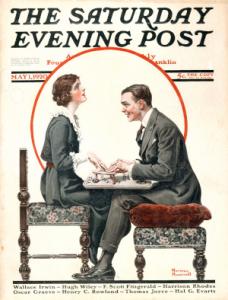
Thus the Ouija board, with roots in Swedenborgian and Spiritualist philosophies that put a benevolent God in firm charge of the universe with no room for a Devil, regarded for decades as something safe enough for Normal Rockwell and I Love Lucy, became a prime target of America’s Satanic Panic because it was included in a scary movie.
But the board remains an object of interest — not just for occultists, but for scientists studying cognition. A 2012 paper in Consciousness and Cognition investigated how ideomotor actions express unconscious thought. It asked subjects yes-or-no general knowledge questions, either directly or via a Oujia board which they thought they were operating with a partner but were in fact controlling through their own ideomotor action.
The researchers found that when subjects reported that they didn’t know an answer and had to guess, their odds were 50/50 when directly answering — but when answering though the board, they were right 65% of the time. They concluded that ideomotor actions can express information that cannot be consciously accessed.[Gauchou]
It seems that the Ouija board can indeed be a source of extraordinary knowledge — not a channel to a metaphysical world of the spirits of the departed, nor to a hell of demons and devils, but our own intuition.
References
Abbott, Karen. “‘A Very Common Delusion’: Spiritualism and the Fox Sisters”. Smithsonian.com, 29 Oct 2012. https://www.smithsonianmag.com/history/a-very-common-delusion-spiritualism-and-the-fox-sisters-97825064/
Ager, John C. Heaven and Its Wonders and Hell, Standard Edition. By Emanuel Swedenborg, Swedenborg Foundation, 2009. https://swedenborg.com/wp-content/uploads/2013/03/swedenborg_foundation_heaven_and_hell.pdf
Braid, James. Observations on trance, or, Human hybernation. J. Churchill, 1850. https://archive.org/details/observationsont01braigoog
Bozzuto, James C. “Cinematic Neurosis Following “The Exorcist”: Report of Four Cases.” The Journal Of Nervous And Mental Disease: July 1975 – Volume 161 – Issue 1 – p 43-48. https://journals.lww.com/jonmd/Abstract/1975/07000/CINEMATIC_NEUROSIS_FOLLOWING__THE_EXORCIST__Report.5.aspx
Carpenter, William B. “On the influence of Suggestion in Modifying and directing Muscular Movement, independently of Volition.” Royal Institution of Great Britain. 1852. Weekly Evening Meeting, Friday, March, 12., p. 147-153. (Reproduced at: Aus unserer Abteilung Medizinische Psychosomatik, Psychopathologie und Psychiatrie, Bereich Psychomotorik. IP-GIPT. Erlangen: https://www.sgipt.org/medppp/psymot/carp1852.htm)
Cassie, Ron. “Not Dead Yet.” Baltimore Magazine. 20 Oct 20 2015. https://www.baltimoremagazine.com/section/artsentertainment/the-dark-and-fascinating-history-of-the-ouija-board-baltimore-origins
Conliffe, Ciaran. “The Fox Sisters and the Birth of Spiritualism.” HeadStuff.org. https://www.headstuff.org/culture/history/fox-sisters-birth-spiritualism/
Davenport, Reuben Briggs. “The Death-Blow to Spiritualism: Being the True Story of the Fox Sisters. G. W. Dillingham Co, 1888. https://archive.org/details/deathblowtospiri00daverich
Davis, Andrew Jackson. The Magic Staff. J. S. Brown, 1859. https://babel.hathitrust.org/cgi/pt?id=wu.89076802974
Davis, Andrew Jackson. The Principles of Nature, Her Divine Revelations, and a Voice to Mankind
S. S. Lyon and Wm. Fishbough, 1847. https://archive.org/details/principlesofnatu00davi
Drabelle, Dennis. “Feet and Faith.” The Pennsylvania Gazette, Vol 104 No.4, 03 Mar 2006. University of Pennsylvania. https://www.upenn.edu/gazette/0306/feature2.html
Dupotet, Jules. An Introduction to the Study of Animal Magnetism. Saunders & Otley, 1838. https://archive.org/details/anintroductiont01conggoog
Franklin, James. “Mozart, Mesmer and medicine.” Hektoen International Journal, Winter 2012. https://hekint.org/2017/01/30/mozart-mesmer-and-medicine/
“Franz Anton Mesmer.” Theosophy Trust Memorial Library. https://www.theosophytrust.org/268-franz-anton-mesmer
Gauchou, Hélène L., Ronald A. Rensink, and Sidney Fels. “Expression of Nonconscious Knowledge via Ideomotor Actions”. Consciousness and Cognition, Vol 21, Issue 2, June 2012, p. 976-982 https://www.sciencedirect.com/science/article/abs/pii/S1053810012000402; https://www2.psych.ubc.ca/~rensink/publications/download/Ouija-GRF.pdf
Greer, John Michael. “A Prophet and a Loss”. ecosophia.net. 17 Jun 2020. https://www.ecosophia.net/a-prophet-and-a-loss/.
Harding, Brian R. “Swedenborgian Spirit and Thoreauvian Sense: Another Look at Correspondence.” Journal of American Studies, vol. 8, no. 1, 1974, pp. 65–79. JSTOR, https://www.jstor.org/stable/27553085.
McRobbie, Linda Rodriguez. “The Strange and Mysterious History of the Ouija Board”. Smithsonian.com, 27 Oct 2013. https://www.smithsonianmag.com/history/the-strange-and-mysterious-history-of-the-ouija-board-5860627/
Murch, Robert. “Detailed History of William Fuld and the Ouija Board.” https://www.williamfuld.com/ouija1.html
Occult Museum. “Speaking with Spirits: The Fox Sisters and the Birth of Spiritualism.” The Occult Museum.com. http://www.theoccultmuseum.com/speaking-spirits-fox-sisters-birth-spiritualism/
Podmore, Frank. Mesmerism And Christian Science. https://archive.org/details/39002053914348.med.yale.edu/
Rose, Jane. “Franz Anton Mesmer, the Man Who Invented Hypnotism.” MentalFloss. https://www.mentalfloss.com/article/500464/franz-anton-mesmer-man-who-invented-hypnotism
Smyth, Julian K. and William F. Wunsch, ed. The Gist Of Swedenborg. New York: Swedenborg Foundation, Inc., 1920. https://www.gutenberg.org/files/15768/15768-h/15768-h.htm#COMMUNICATION_WITH_THE_SPIRITUAL_WORLD
Stefanidakis, Simeon. “Forerunners to Modern Spiritualism: Emanuel Swedenborg (1688-1772)”. First Spiritual Temple. http://www.fst.org/spirit2.htm
Stuart, Nancy Rubin. “The Fox Sisters: Spiritualism’s Unlikely Founders.” American History Magazine, Aug 2005. https://www.historynet.com/the-fox-sisters-spiritualisms-unlikely-founders.htm
Weisberg, Barbara M. “They Spoke With The Dead”. American Heritage, Sep 1999, Vol 50 Issue 5. https://www.americanheritage.com/they-spoke-dead
White, Edward. “In the Joints of Their Toes.” The Paris Review: The Daily. 4 Nov 4 2016. https://www.theparisreview.org/blog/2016/11/04/in-the-joints-of-their-toes/
Wood, Gillen D’Arcy. “The Forgotten American Explorer Who Discovered Huge Parts of Antarctica.” Smithsonian.com, 26 Mar 2020. https://www.smithsonianmag.com/science-nature/charles-wilkes-antarctica-explorer-180974432/
Zeitler, William. “Franz Mesmer.” The Glass Armonica. http://www.glassarmonica.com/armonica/mesmer.php
Zeitler, William. “What’s Different About the Sound of Singing Bowls?” The Glass Armonica. http://glassarmonica.com/armonica/singing_bowls.php







